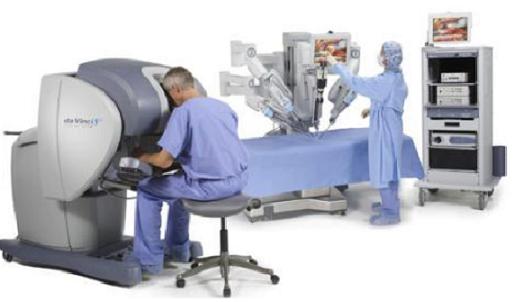
The introduction of computer guidance and robotics into surgical procedures has been driven by the desire to make operations both less invasive and more precise. Minimally invasive surgical (MIS) techniques have become increasingly widespread in multiple surgical disciplines. The goal of MIS is to reduce the patient’s pain, intraoperative blood loss, risk of post operative infection, and recovery time by decreasing the trauma of large incisions from conventional open surgeries. Additional benefits include improved cosmesis, reduced convalescence and hospital costs, and less time away from productive work. It is important to stress the fact that the term ‘minimally invasive’ does not relate to the size of skin incision only, but to the overall degree of soft tissue damage necessary to prepare for and place the implants. Some companies now offer new instruments allowing for very minimal incisions and reduced soft tissue compromise.
A surgical robot is a powered computer controlled manipulator with artificial sensing that can be reprogrammed to move and position tools to carry out a range of surgical tasks. The robot can assist the surgeon in numerous ways such as carrying out repetitive motions automatically, thus relieving the surgeon of tiring tasks; accurately positioning tools at a predefined location or to move them with micromotions or through a complex path. This necessitates the need for accurately defining the target tissue, accurate imaging, computer modeling and for registration of the robot and tools to both the patient and to the imaging.
Computer Assisted Surgery (CAS) versus Robotics Assisted Surgery (RAS)
The above mentioned benefits and requirements are equally applicable to CAS, but robots tend to provide greater accuracy and precision than CAS. The surgeon holds the tools in CAS and could ignore all warnings to the contrary and cut into unsafe regions. The robot, on the other hand, can be programmed to prevent motions into critical regions or only allow motions along a specified direction (e.g. in orthopedic surgery, to drill an angled hole or cut to an inclined plane). Thus, provided the robot itself is considered to be safe, robots can enhance the safety of the procedure compared with conventional surgery and to CAS.
Compared with CAS systems, the potential benefits available to a well-designed robotic surgery system are:
- The ability to move in a predefined and reprogrammable complex three-dimensional path, both accurately and predictably.
- The ability to accurately and repeatedly position and orientate at a reprogrammable point or at a series of points. While CAS systems may also have this ability, robot accuracy is generally higher.
- The ability to make repetitive motions, for long periods, tirelessly.
- The ability to move to a location and then hold tools there for long periods accurately, rigidly and without tremor.
- The ability to actively constrain tools to a particular path or location, even against externally imposed forces, thus preventing damage to vital regions. This can lead to safer procedures than those achieved using CAS.
- To be able to move, locate and hold tools within hazardous environments without damage to the surgeon (e.g. from fluoroscopic or radioactive sources).
- To be able to make precise micromotions with pre-specified microforces.
- To be able to respond and adapt very quickly and automatically, either in response to sensor signals or to changes in commands.
- To be able to perform ‘keyhole’ minimal access surgery, without the aid of vision and without forgetting the path or the location.
Strengths and Limitations of Humans versus Robots
| HUMANS | ROBOTS |
|---|---|
| Strengths | Strengths |
| Strong hand-eye coordination | Strong hand-eye coordination |
| Dexterous (at human scale) | Stable and untiring |
| Flexible and adaptable | Can be designed for a wide range of scales |
| Can integrate extensive and diverse information | Can use diverse sensors (chemical, force, acoustic, etc.) in control |
| Able to use qualitative information | Resistant to radiation and infection |
| Good judgement | May be sterilized |
| Easy to instruct and debrief | |
| Limitations | Limitations |
| Limited dexterity outside natural scale | Poor judgement |
| Prone to tremor and fatigue | Expensive |
| Limited geometric accuracy | Expensive |
| Limited geometric accuracy | Limited to relatively simple procedures |
| Limited ability to use quantitative information | Limited dexterity and hand-eye coordination |
| Large operating room space requirement | Technology in flux |
| Limited sterility | Difficult to construct and debug |
| Susceptible to radiation and infection |
Adapted from Tayler & Stulberg (75)